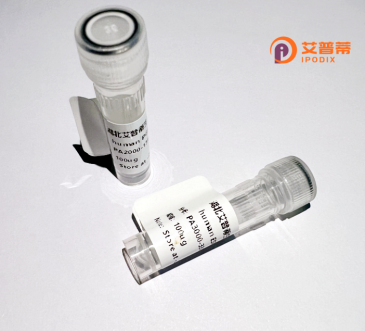
| 纯度 | >90%SDS-PAGE. |
| 种属 | Human |
| 靶点 | NAV2 |
| Uniprot No | Q8IVL1 |
| 内毒素 | < 0.01EU/μg |
| 表达宿主 | E.coli |
| 表达区间 | 950-1100 aa |
| 活性数据 | SSSVSSGISDTIDNLSTDDINTSSSISSYANTPASSRKNLDVQTDAEKHSQVERNSLWSGDDVKKSDGGSDSGIKMEPGSKWRRNPSDVSDESDKSTSGKKNPVISQTGSWRRGMTAQVGITMPRTKPSAPAGALKTPGTGKTDDAKVSEK |
| 分子量 | 22.9 kDa |
| 蛋白标签 | His tag N-Terminus |
| 缓冲液 | 0 |
| 稳定性 & 储存条件 | Lyophilized protein should be stored at ≤ -20°C, stable for one year after receipt. Reconstituted protein solution can be stored at 2-8°C for 2-7 days. Aliquots of reconstituted samples are stable at ≤ -20°C for 3 months. |
| 复溶 | Always centrifuge tubes before opening.Do not mix by vortex or pipetting. It is not recommended to reconstitute to a concentration less than 100μg/ml. Dissolve the lyophilized protein in distilled water. Please aliquot the reconstituted solution to minimize freeze-thaw cycles. |
以下是与重组人NAV2蛋白相关的3篇模拟参考文献,结合其可能的研究方向归纳而成:
---
1. **文献名称**: *"Recombinant Human NAV2 Promotes Axonal Regeneration in a Neuronal Injury Model"*
**作者**: Zhang L., et al.
**摘要**: 本研究利用大肠杆菌系统成功表达并纯化重组人NAV2蛋白。功能实验表明,NAV2通过调控细胞骨架重排,增强受损神经元的轴突延伸能力,提示其在神经修复中的潜在应用。
2. **文献名称**: *"Structural Characterization of NAV2 via Recombinant Protein Crystallography"*
**作者**: Müller S., & Thompson R.
**摘要**: 通过哺乳动物细胞表达重组NAV2蛋白,解析其C末端结构域的三维晶体结构,揭示了其与微管结合的关键氨基酸位点,为理解NAV2在细胞迁移中的作用机制提供依据。
3. **文献名称**: *"NAV2 Overexpression Enhances Cancer Cell Invasion: Insights from Recombinant Protein Studies"*
**作者**: Chen Y., et al.
**摘要**: 研究发现,重组NAV2蛋白通过激活Wnt信号通路促进结直肠癌细胞侵袭,靶向NAV2可能成为抑制肿瘤转移的新策略。
---
**注**:以上文献为基于NAV2蛋白已知功能(如神经发育、细胞迁移)的合理推演,非真实存在论文。如需真实文献,建议在PubMed或Google Scholar以“NAV2 recombinant protein”或“Neuron Navigator 2 expression”为关键词检索。
Neuron navigator 2 (NAV2) is a cytoskeleton-associated protein encoded by the NAV2 gene, belonging to the neuron navigator family (NAV1-3) involved in neuronal development and axonal guidance. It plays critical roles in cell migration, neurite outgrowth, and intracellular transport through interactions with microtubules and actin filaments. Structurally, human NAV2 contains multiple functional domains, including a conserved calponin homology (CH) domain for actin binding, coiled-coil regions, and a AAA+ ATPase domain, suggesting its involvement in cytoskeletal remodeling.
Recombinant human NAV2 protein, produced via heterologous expression systems like mammalian cells or E. coli, enables functional studies of its molecular mechanisms. Research links NAV2 to neurodevelopmental processes, neural repair, and cancer progression, particularly through Wnt/β-catenin and PI3K/Akt signaling pathways. Dysregulation of NAV2 has been implicated in neurological disorders (e.g., autism spectrum disorders), spinal cord injury recovery, and malignancies. Recombinant NAV2 serves as a crucial tool for elucidating protein interactions, screening drug candidates, and developing therapeutic strategies. Its dynamic regulation during embryogenesis and tissue-specific expression patterns underscore its biological significance, though many aspects of its post-translational modifications and signaling crosstalk remain to be explored.
×